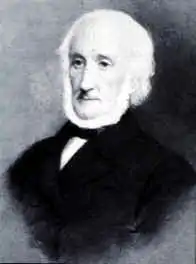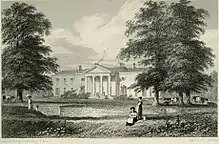George Petrie | |
|---|---|
 Portrait of Petrie, by Bernard Mulrenin | |
| Born | 1 January 1790 |
| Died | 17 January 1866 |
| Occupation(s) | Painter, Antiquarian |
George Petrie (1 January 1790 – 17 January 1866) was an Irish painter, musician, antiquarian and archaeologist of the Victorian era[1] who was instrumental in building the collections of the Royal Irish Academy and National Museum of Ireland.
Personal life
George Petrie was born in Dublin, Ireland, and grew up there, living at 21 Great Charles Street, just off Mountjoy Square.[2] He was the son of the portrait and miniature painter James Petrie, a native of Aberdeen, Scotland, who had settled in Dublin. He was interested in art from an early age. He was sent to the Dublin Society's Schools, being educated as an artist, where he won the silver medal in 1805, aged 15.
Career

After an abortive trip to England in the company of friends Francis Danby and James Arthur O'Connor, he returned to Ireland where he worked mostly producing sketches for engravings for travel books – including among others, George Newenham Wright's guides to Killarney, Wicklow and Dublin, Thomas Cromwell's Excursions through Ireland, and James Norris Brewer's Beauties of Ireland.
In the late 1820s and 1830s, Petrie significantly revitalised the Royal Irish Academy's antiquities committee. He was responsible for their acquisition of many important Irish manuscripts, including an autograph copy of the Annals of the Four Masters, as well as examples of insular metalwork, including the Cross of Cong and Roscrea Brooch.[3]
His writings on early Irish archaeology and architecture were of great significance, especially his essay on the Round Towers of Ireland, which appeared in his 1845 book titled The Ecclesiastical Architecture of Ireland. He is often called "the father of Irish archaeology". His survey of the tombs at Carrowmore still informs study of the site today.
From 1833 to 1843, he was employed by Thomas Colby and Thomas Larcom as head of the Topographical Department (the antiquities division) of the Irish Ordnance Survey. Amongst his staff were John O'Donovan and Eugene O'Curry.
A prizewinning essay submitted to the Royal Irish Academy in 1834 on Irish military architecture was never published, but his seminal essay On the History and Antiquities of Tara Hill was published by the Academy in 1839. During this period Petrie was himself the editor of two popular antiquarian magazines, the Dublin Penny Journal and, later, the Irish Penny Journal.
Another major contribution of Petrie's to Irish culture was the collection of Irish traditional airs and melodies which he published in 1855 as The Petrie Collection of the Ancient Music of Ireland. The first commercial recording of Petrie's collection was The Petrie Collection of the Ancient Music of Ireland (the 1855 Edition of 147 Airs & the 1882 Edition of 40 Airs) [2007, 8-cd set, Trigon TRD 1526, 187 tracks] arranged and performed by Irish pianist J.J. Sheridan. William Stokes's contemporary biography includes detailed accounts of Petrie's working methods in his collecting of traditional music: "The song having been given, O'Curry wrote the Irish words, when Petrie's work began. The singer recommenced, stopping at a signal from him at every two or three bars of the melody to permit the writing of the notes, and often repeating the passage until it was correctly taken down ..."
As an artist, his favourite medium was watercolour which, due to the prejudices of the age, was considered inferior to oil painting. Nonetheless, he can be considered one of the finest Irish Romantic painters of his era. Some of his best work is in the collections of the National Gallery of Ireland, such as his watercolour painting Gougane Barra Lake with the Hermitage of St Finbarr, Co. Cork (1831).
He was awarded the Royal Irish Academy's prestigious Cunningham Medal three times: firstly in 1831 for his essay on the round towers, secondly in 1834 for the essay (now lost) on Irish military architecture, and thirdly in 1839 for his essay on the antiquities of Tara Hill.[4]
Works
- incomplete, only larger works listed
- Music
- Petrie, George (ed.), The Petrie Collection of the Ancient Music of Ireland, M. H. Gill, Dublin
- Volume 1, 1855
- Volume 2, 1882 , uncompleted fragment published posthumously
- Illustrations
- Wright, G.M., ed. (1832), Ireland Illustrated from Original Drawings by G. Petrie, W.H. Bartlett, & T.M. Baynes with descriptions by G.N. Wright, H. Fisher, Son, and Jackson
- Wright, G.M., ed. (1821), An Historical Guide to Ancient and Modern Dublin. Illustrated with engravings after drawings by George Petrie, Esq., Baldwin, Cradock, and Joy : London
- Wright, G.M., ed. (1834), A Guide to the Giant's Causeway, and the North East Coast of the County of Antrim. Illustrated by Engravings, after designs of George Petrie, Esq., William Curry, Jun. and Company : Dublin ; Simpkin and Marshall : London
- Antiquarian works
- The Ecclesiastical Architecture of Ireland, anterior to the Anglo-Norman invasion; comprising an essay on the origin and uses of the Round Towers of Ireland (2nd ed.), Hodges and Smith : Dublin, 1845 [1833]
- Also as Petrie, George (1845), "An Inquiry into the Origin and Uses of the Round Towers of Ireland; Comprising Remarks on the Ecclesiastical Architecture of Ireland Anterior to the Anglo-Norman Invasion", The Transactions of the Royal Irish Academy, Royal Irish Academy, 20: iii–521, JSTOR 30078994
- An Essay on Military Architecture in Ireland Previous to the English Invasion, 1834 , unpublished, won a gold medal from the Royal Irish Academy, see (Petrie & O'Malley 1972)
- Petrie, George (1839), "On the History and Antiquities of Tara Hill", The Transactions of the Royal Irish Academy, Royal Irish Academy, 18: 25–232, JSTOR 30078991
- Petrie, George (1850), "On the Cross of Cong", Proceedings of the Royal Irish Academy, Royal Irish Academy, 4: 572–585, JSTOR 20520370
References
- ↑ Webb, Alfred. "George Petrie – Irish Biography". libraryireland.com. Library of Ireland. Retrieved 23 September 2020.
- ↑ Cowell, John (1996). Dublin's Famous People and where they lived. O'Brien Press Ltd. p. 149.
- ↑ Briggs, Stephen. "The Roscrea Brooch Re-Provenanced?", Ulster Journal of Archaeology, volume 74, 2017. pp. 74-86. JSTOR 26788433
- ↑ "An Historical Account of the Cunningham Fund", Proceedings of the Royal Irish Academy, 7: 406–419, 1857, JSTOR 20489903
Sources
- Cooper, David. The Petrie Collection of the Ancient Music of Ireland. Cork University Press, 2002
- Crooke, Elizabeth. Politics, Archaeology and the Creation of a National Museum of Ireland: An Expression of National Life. Dublin: Irish Academic Press, 2001. ISBN 978-0-7165-2729-9
- Stanford, Charles Villiers, ed. (1902–1905), The Complete Collection of Irish Music as Noted by George Petrie, vol. 3 vols., Boosey & Co., London
- Petrie, George; O'Malley, D. J. S. (1972), "Aspects of George Petrie. V. An Essay on Military Architecture in Ireland Previous to the English Invasion", Proceedings of the Royal Irish Academy: Archaeology, Culture, History, Literature, Royal Irish Academy, 72: 219–269, JSTOR 25506268
- Cox, Michael F. (May 1913), "George Petrie", The Irish Monthly, Irish Jesuit Province, 41 (479): 233–248, JSTOR 20503385
- Dillon, Myles (Autumn 1967), "George Petrie (1789-1866)", Studies: An Irish Quarterly Review, Irish Province of the Society of Jesus, 56 (223): 266–276, JSTOR 30087830
- Stokes, William (1868), The Life and Labours in Art and Archaeology, of George Petrie, Longmans, Green, & Co.
External links
- Dublin University Magazine 1839
- Free scores by George Petrie at the International Music Score Library Project (IMSLP)
 Church of the Carmelite Friary., a painting engraved by J Rogers for Fisher's Drawing Room Scrap Book, 1833 with a poetical illustration by Letitia Elizabeth Landon.
Church of the Carmelite Friary., a painting engraved by J Rogers for Fisher's Drawing Room Scrap Book, 1833 with a poetical illustration by Letitia Elizabeth Landon. Howth Light-House., a painting engraved by Edward Goodall for Fisher's Drawing Room Scrap Book, 1835 with a poetical illustration by Letitia Elizabeth Landon.
Howth Light-House., a painting engraved by Edward Goodall for Fisher's Drawing Room Scrap Book, 1835 with a poetical illustration by Letitia Elizabeth Landon.